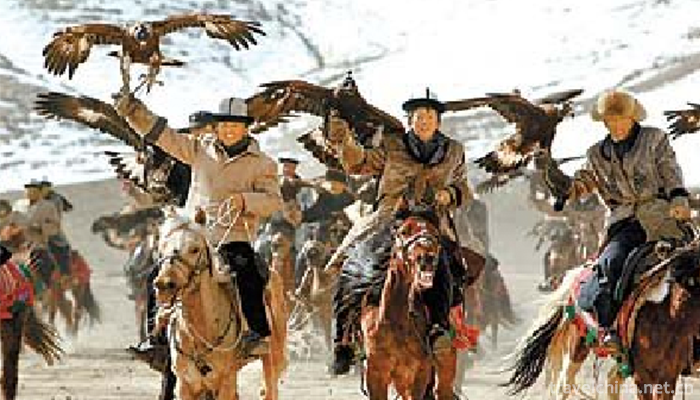Kirgiz hawk taming custom
Kirgiz hawk taming custom
Originating in the East, the Falcon has a history of 4000 years. The custom of taming Eagles has been handed down orally without any written records. However, the Kirgiz people have kept the saying of taming Eagles for thousands of years. Falcons and hunting require great patience and energy, and no one wants to learn now. Eagles are fierce and unruly. Generally, they are fed and domesticated from the young eagles. But it is time-consuming and laborious. The trained eagle is too weak and lacks the attack power of the wild eagle. The real Eagle tamer catches and domesticates the adult Eagle directly. The difficulty is great, but once domesticated, the power doubles. Hundreds of falcons domesticated by themselves. Whenever hunting in winter, Kirgiz falcons cross horses with their hands, and gallop among mountains, forests and grasslands with their fierce falcons, they will reap something.
On May 23, 2011, Kirgiz hawk taming custom was approved by the State Council and listed in the third batch of national intangible cultural heritage list.
Custom introduction
June 2011 was selected as the third batch of national intangible cultural heritage list.
Number: 1218 Item Number: X-143 Declaration Area or Unit: Aheqi County, Xinjiang Uygur Autonomous Region
Kirgiz people have a close relationship with eagles. For thousands of years, their place of residence has been called "the land of falcons". In the years without guns, people tamed fierce eagles to hunt for themselves, and a good Falcon could feed a family. In the past, the price of an eagle was higher than the dowry of a Kirgiz girl. Raising eagles is also a luxury. A hawk-taming license costs 500 yuan, not to mention that this fellow can eat two kilograms of meat per meal, but it has to be fresh.
There was a time when Hawking was forbidden by the state to protect wildlife. Two years later, the ban was lifted because it was understood that hawk-taming was a unique folk custom of Kirgiz people for thousands of years, which needed protection and inheritance. Kirgiz and eagles abide by an agreement: they never nest this precious raptor, always quietly take away the most desirable Eagle home for domestication.
A good Eagle tamer needs three qualities: hobby, stability and strength. All three are indispensable.
Falcon Township
Aheqi County, located in the hinterland of the southern vein of the Tianshan Mountains in Western Xinjiang, is located in the alpine mountainous area. The Southern vein of the northern Tianshan Mountains and the southern Karatek Mountains are sandwiched with a narrow Toshkent Valley. In the foothills of valleys and mountains, there are plenty of water and grass in summer and autumn, which provide enough food for falcons, such as rabbits, mice and even foxes. The Kirgiz and their Falcons have found their paradise here.
Since ancient times, Falcons have been a member of the family of Kirgiz herdsmen. After the falcons were listed as second-class protected animals in China, they have registered their "household registration" for their falcons.
Sumutashi Township in Aheqi County is named "Falcon Township" by the Ministry of Culture of China. There are more than 400 herdsmen in this town, almost all of them will domesticate and hunt falcons. The herdsmen hope to continue domesticating falcons, but they do not want to break the law.
The Kirgiz hawk taming artists in Aheqi County, Xinjiang, have learned a lot about hawking, boiling, taming, releasing, playing with hawks and smuggling of falcons, which has lasted for seven years. Aheqi County is a place where Kirgiz people live together. Kirgiz people account for nearly 80 percent. Since the original way of Falcon domestication is still completely preserved here, it is also known as the "home of falcons" in China, and the local Kirgiz are also known as the "King of Eagles". Origin of Falcon Country. "In 1991, Andrew, a British hawk trainer, visited Sumatash, Ahoc County, to study hawk training skills. He said that in the world, the home of the Falcon is Sumatash, Ahoc County. And more than 400 herdsmen in Sumatashi, who domesticate eagles and hunt, are the true home of eagles. Every winter, Hundreds of falcons gather in Sumatash, holding days of Falcon hunting competitions, which are more interesting and exciting than watching bullfighting in Spain.


-
1.Deng Xiaopings Hometown Tourist Area
Located in Xiexing Town, Guang'an District, Guang'an City, Sichuan Province, Guang'an City, Deng Xiaoping Hometown Tourist Area covers an area of 3.19 square kilometers
Time 2018-12-12 -
2.Chengshantou Scenic Spot
Chengshantou Scenic Spot is located at the easternmost end of Chengshan Mountains in Rongcheng City, Shandong Province, so it is named Chengshantou. Chengshantou is 200 meters above sea level
Time 2019-01-05 -
3.The Gu Guan Great Wall
Guguan Great Wall is located in Xinguancun, Pingding County, Shanxi Province, on the western side of Taihang. It starts at Niangziguan Jiayugou in the north and reaches Baihui Village in the south.
Time 2019-01-12 -
4.Sea cucumber with eight treasures
Babao sea cucumber is a traditional dish in Yichang City, Hubei Province. "Babao" means ham, hoof tendons, chicken, winter bamboo shoots, shrimp, mushrooms, lotus seeds and water chestnut; i
Time 2019-03-25 -
5.Caogao Gong and drum in northern Sichuan
Licao Gong and drum in northern Sichuan is a kind of traditional folk music. It mainly distributes in four counties and three districts of Guangyuan City, Sichuan Province
Time 2019-04-18 -
6.Panda Dance
Panda dance is a traditional dance originating in Jiuzhaigou County. Every year on the 15th and 16th of the first lunar month, some of the Baima Tibetans wear panda masks to exorcise evil spirits.
Time 2019-04-26 -
7.Kimchi Making Skills Korean Kimchi Making Skills
Kimchi of Korean nationality is one of the traditional food with the most national characteristics of Korean nationality, and its pickling method is constantly enriched and developed. In the long hist
Time 2019-06-09 -
8.Siping Opera
Siping Opera, also known as Sijuan Opera, Siping Opera, Sipeng Opera and Sipeng Opera, is popular in Pingnan County, Zhenghe County, Fujian Province. It is one of the national intangible cultural heri
Time 2019-06-16 -
9.Tujia Folk Songs
Tujia folk song is a unified folk song composed of lyrics and music. It is the product of the intersection of literature and music. The lyrics of Tujia folk songs belong to the language art, which exp
Time 2019-06-23 -
10.Evolution of Chengdu Giant Panda Base
Chengdu Giant Panda Breeding Research Base is established on the basis of raising, treating and breeding giant pandas in Chengdu Zoo. In the 1980s, Fargesia FRIGIDA in Qionglai mountains blossomed and died. Some giant pandas were rescued and concentrated in Chengdu Zoo for lack of food and hunger.
Time 2020-12-13 -
11.Education in Luzhou
In 2017, the construction area of the completed school buildings in Luzhou city was 842500 square meters; 670 million yuan of tuition free, financial aid, and nutrition lunch program was arranged to subsidize students with financial difficulties from families, and 79747 students with financial
Time 2020-12-14 -
12.Dazhous secondary industry
In 2019, the added value of all industries in Dazhou is 46.35 billion yuan, an increase of 8.7% over the previous year, of which the added value of industries above Designated Size will increase by 9.6% (see Table 2). Among the industries above
Time 2020-12-20